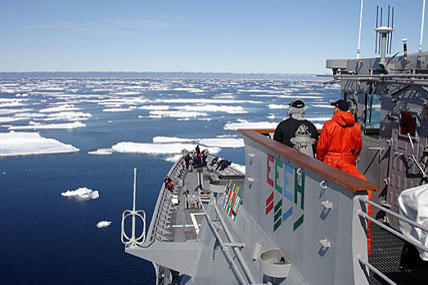With ice melting at a rapid rate, new waterways opening up, and the amount of shipping through the area on the increase, Defense Secretary Chuck Hagel unveiled the Pentagon's debut Arctic Strategy on Friday at an international forum in Canada.
The new strategy is designed to address the pace of change in the region and help define parameters designed to increase U.S. presence in the area while strengthening partnerships with Arctic-bordering nations.
"The Arctic is at a strategic inflection point as its ice cap is diminishing more rapidly than projected and human activity, driven by economic opportunity -- ranging from oil, gas, and mineral exploration to fishing, shipping, and tourism -- is increasing in response to the growing accessibility," reads the Pentagon's new DoD Arctic Strategy.
Hagel introduced this strategy during a speech Thursday at the Halifax International Security Forum in Canada. Sen. John McCain, R-Ariz., and Israeli Minister of Defense Moshe Ya'alon also attended the forum.
Hagel acknowledged that global warming has distinctly changed the region and allowed more freedom of movement for naval and coast guard ships in the future.
"Climate change is shifting the landscape in the Arctic more rapidly than anywhere else in the world. While the Arctic temperature rise is relatively small in absolute terms, its effects are significant -- transforming what was a frozen desert into an evolving navigable ocean, giving rise to an unprecedented level of human activity," Hagel told the audience.
The U.S. defense secretary went on to mention the increase in traffic along the Northern Sea Route, the largest Arctic waterway which largely aligns along the Russian border. He said the Pentagon expects traffic in the Northern Sea Route to increase tenfold this year compared to last.
The U.S. has more than 1,000 miles of Arctic coastline along its Alaskan border. The Defense Department has about 22,000 active duty troops and 5,000 Guardsmen and Reservists stationed in Alaska.
"The United States takes its responsibilities as an Arctic nation very seriously, and the United States military has extensive experience operating in the Arctic," Hagel said.
Maintaining a forward presence so as to ensure freedom of the seas is maintained throughout the region is a key objective supporting the strategy, Hagel said.
Hagel mentioned that the Defense Department is thinking about how the Navy will adapt its fleet to the evolving shifts in the region.
In fact, the Navy is getting ready to release its "Updated Arctic Road Map" -- an effort to adjust its 2009 Arctic Road Map to take up more recent questions and concerns regarding the pace of climate change and emerging technology designed to help ships and ship systems operate more effectively in the cold, harsh Arctic weather.
Hagel stressed international partnership as an objective integral to the DoD Arctic Strategy.
"By taking advantage of multilateral training opportunities with partners in the region, we will enhance our cold-weather operational experience, and strengthen our military-to-military ties with other Arctic nations. This includes Russia, with whom the United States and Canada share common interests in the Arctic, creating the opportunity to pursue practical cooperation between our militaries and promote greater transparency," Hagel said.
The strategy is designed to help the U.S. military be ready to respond in the event of man-made or natural disasters.
Protecting the environmental integrity of the Arctic is also a key part of the strategy. Climate change represents a global trend with substantial security dimensions, Hagel said.
"The challenge of global climate change, while not new to history, is new to the modern world. Climate change does not directly cause conflict, but it can add to the challenges of global instability, hunger, poverty, and conflict."




























